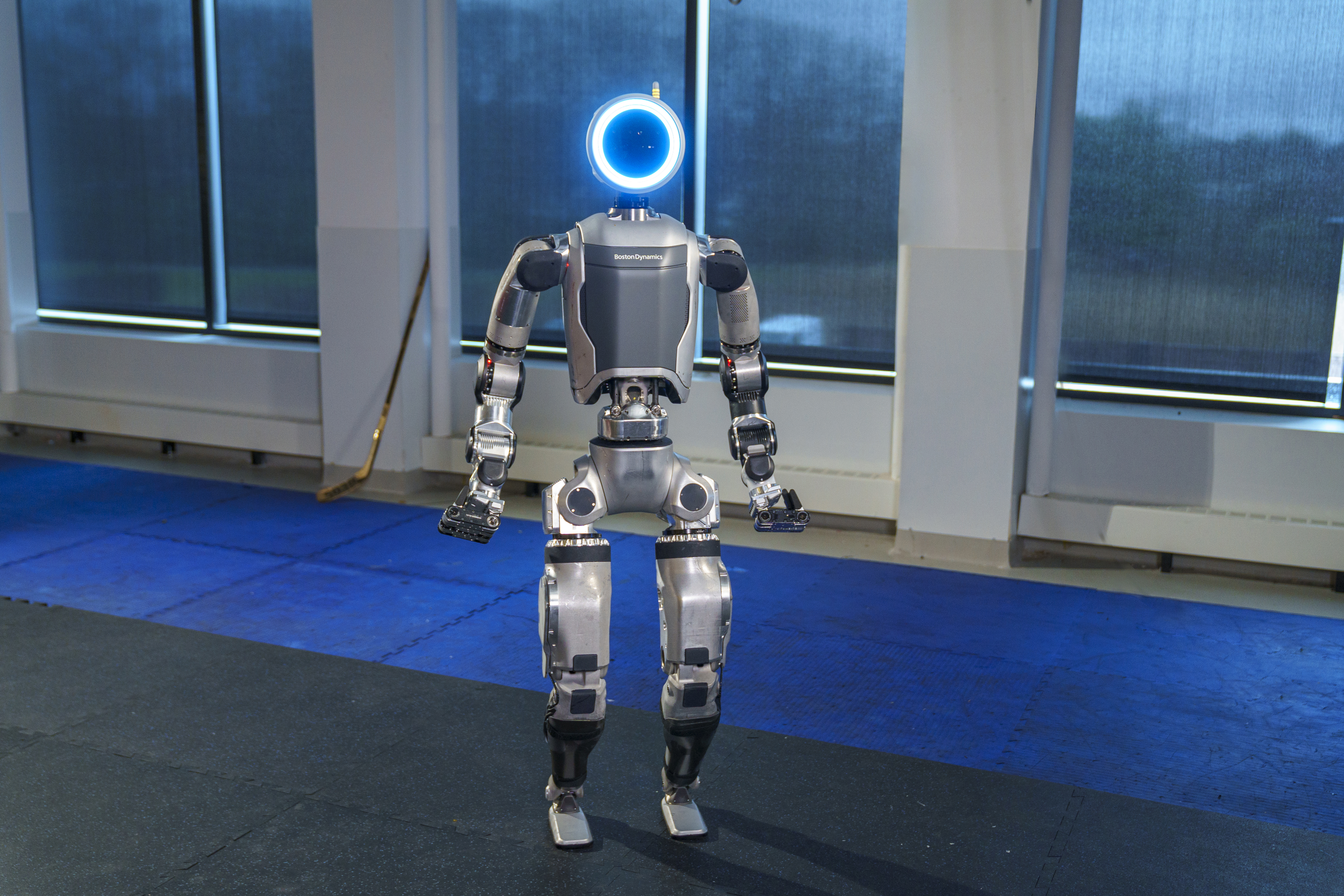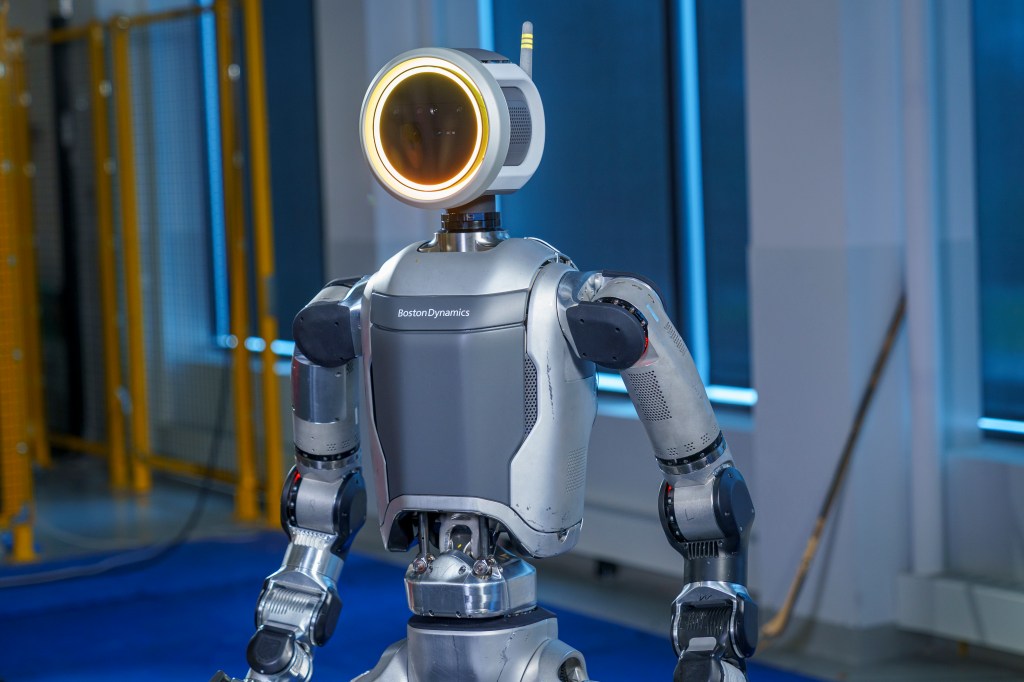Atlas lies motionless in a prone position atop interlocking gym mats. The only soundtrack is the whirring of an electric motor. It’s not quiet, exactly, but it’s nothing compared to the hydraulic jerks of its ancestors.
As the camera pans around the robot’s back, its legs bend at the knees. It’s a natural movement, at first, before crossing into an uncanny realm, like something out of a Sam Raimi movie. The robot, which appeared to be lying on its back, has effectively switched positions with this clever bit of leg rotation.
As Atlas fully stands, it does so with its back to the camera. Now the head spins around 180 degrees, before the torso follows suit. It stands for a moment, offering the camera its first clear view of its head — a ring light forming the perimeter of a perfectly round screen. Once again, the torso follows the head’s 180, as Atlas walks away from the camera and out of frame.
A day after retiring the hydraulic version of its humanoid robot, Boston Dynamics just announced that — like Bob Dylan before it — Atlas just went electric.
The pace is fast, the steps still a bit jerky — though significantly more fluid than many of the new commercial humanoids to which we’ve been introduced over the past couple of years. If anything, the gait brings to mind the brash confidence of Spot, Atlas’ cousin whose branch on the evolutionary tree forked off from the humanoid a few generations ago.
All-new Atlas
The new version of the robot is virtually unrecognizable. Gone is the top-heavy torso, the bowed legs and plated armor. There are no exposed cables anywhere to be found on the svelte new mechanical skeleton. The company, which has warded off reactionary complaints of robopocalypse for decades, has opted for a kinder, gentler design than both the original Atlas and more contemporary robots like the Figure 01 and Tesla Optimus.
The new robot’s aesthetic more closely matches that of Agility’s Digit and Apptronik’s Apollo. There’s a softer, more cartoonish design to the traffic-light-headed robot. It’s the “All New Atlas,” according to the video. Boston Dynamics has bucked its own trend by maintaining the research name for a product it will be positioning toward commercialization. SpotMini became Spot. Handle became Stretch. For now, however, Atlas is still Atlas.
“We might revisit this when we really get ready to build and deliver in quantity,” Boston Dynamics CEO Robert Playter tells TechCrunch. “But I think for now, maintaining the branding is worthwhile.”
The executive’s statement betrays the still early stages of the project. Boston Dynamics’ current timeline has the electric Atlas beginning pilot testing at Hyundai facilities earlier next year, with full production a few years further down the road.
“We’re going to be doing experiments with Hyundai on-site, beginning next year,” says Playter. “We already have equipment from Hyundai on-site. We’ve been working on this for a while. To make this successful, you have to have a lot more than just cool tech. You really have to understand that use case, you’ve got to have sufficient productivity to make investment in a robot worthwhile.”
Doing a 180

What’s most striking about the 40-second “All New Atlas” teaser is the robot’s movements. They’re a reminder that building a humanoid robot doesn’t require making the robot as human as possible. As an investor pointed out to me years back, billions of years of evolution hasn’t made us humans perfect machines. If we are going to create machines in our own images, why not build ones that can do things we can’t?
“We built a set of custom, high-powered and very flexible actuators at most joints,” says Playter. “That’s a huge range of motion. That really packs the power of an elite athlete into this tiny package, and we’ve used that package all over the robot.”
One thing worth keeping in mind while watching the footage is that Boston Dynamics has made its name across decades of viral videos. Recent additions to the canon are just as likely to showcase a ’bot’s dance moves as they are anything genuinely useful in an industrial setting. For that reason, it’s difficult to decouple what the company has deemed real functionality and what is just a bit of showing off.
Starting in the prone position, for instance, is an opportunity to showcase that cool reverse crab leg trick — but it’s practical, as well. As Boston Dynamics was more than happy to showcase in the hydraulic Atlas’ farewell video, falling down is part of the job — and so, too, is getting up. The truth of the matter is that most of the current crop of industrial robots require human intervention when they fail. A robot that can simply dust itself off and get back to work, on the other hand, is a big win for productivity.
The system’s ability to turn on a dime also lends considerably to its productivity potential. It brings to mind Agility’s Digit demos (the company is notably the only one of its ilk demoing systems at this scale), wherein a robot walks to a shelf, turns around, walks to the conveyer belt, turns around and walks back. Multiply that job by hundreds — or even thousands — of times a day, and you begin to see the value of shaving off precious seconds.
“It’s going to be capable of a set of motions that people aren’t,” explains Playter. “There will be very practical uses for that.”
Significantly reducing the robot’s turn radius is also important in tight spaces. Remember, these machines are meant to be brownfield solutions — that is, they’re designed to be plugged into existing workflows in existing spaces. Increased maneuverability could ultimately mean the difference between working in a setting and having to redo the layout.
Head and hands

The hands aren’t brand new for the video, having previously made appearances on the hydraulic model. They do, however, also represent the company’s decision to not hew entirely to human design as a guiding force. Here, the difference is as simple as opting for three fingers, instead of four on the end effectors.
“There’s so much complexity in a hand,” says Playter. “When you’re banging up against the world with actuators, you have to be prepared for reliability and robustness. So, we designed these with fewer than five fingers to try to control their complexity. We’re continuing to explore generations of those. We want compliant grasping, adapting to a variety of shapes with rich sensing on board, so you understand when you’re in contact.
Internally, the most contentious aspect of the design may well be the head. The big, round display has shades of a cosmetic mirror.
“It was one of the design elements we fretted over quite a bit,” says Playter. “Everybody else had a sort of humanoid shape. I wanted it to be different. We want it to be friendly and open. It provides a palette for a display. Of course, there are sensors buried in there, but also the shape is really intended to indicate some friendliness. That will be important for interacting with these things in the future.”
An Atlas for Christmas

The landscape has changed dramatically in the decade since the hydraulic Atlas’ introduction. Electric Atlas has a fair bit of company, in the form of humanoid robots from Figure, Apptronik, Tesla and 1X, among others.
“For us, there’s obviously been a huge influx of interest. I think that influx has been motivated by three events. Boston Dynamics got acquired [by Hyundai] for nearly a billion dollars. That sort of woke everybody up like, ‘whoa, there’s an exit path.’ Tesla expressing interest in manufacturing sort of validated things we’ve been doing for a long time. And then, the emergence of AI as a tool to help deal with generality is making all of this feasible. We’ve been patient to announce, because we wanted to do enough research to understand that we can solve manipulation problems and be confident in a new generation of machine.
In spite of Boston Dynamics’ big head start in humanoids, Playter says the company got the new robot’s first build together around Christmas 2023. Before that, it was working through many of the more complex problems in simulation.
This week, it seems, the company is finally ready to begin showing off what the robot can do — or at least the early stages of what it’s planning with the system.
General intelligence
One thing you can definitely say about Elon Musk is the guy makes big promises. In the earliest public-facing days of Optimus, when the Tesla ’bot appeared to be little more than a spandex-clad human, the executive spoke of a system that could do it all. Your Optimus could work all day in the factory, do your grocery shopping and then cook you dinner. That’s the dream, right?
The truth of the matter is, of course, one built around baby steps. Robotics firms may already be discussing “general-purpose humanoids,” but their systems are scaling one task at a time. For most, that means moving payloads from point A to B. Truly utilizing the form factor, however, will require a more generalized intelligence.
It appears the app store model might present the clearest path there. Developer access has, after all, been a big part of growing out Spot’s feature set. Playter, however, says Boston Dynamics won’t be taking that approach with Atlas.
“We are definitely going to target an application ourself and not build a platform,” he says. Our experience is that the way to go fast is for us to focus on an application and go solve problems — and not assume someone else is going to solve it for us. I do think AI is an essential piece here. To support the generality of tasks is going to take and will be reinforced with AI techniques.”
The company recently opened access to Spot’s reinforcement learning algorithm for developers. That work will be foundational to Atlas’ growing skillset.
Outside the box
To be successful, Playter explains, humanoids have to move beyond the boxes.
“I think you can do that with so many other robots,” he says. “Humanoids need to be able to support a huge generality of tasks. You’ve got two hands. You want to be able to pick up complex, heavy geometric shapes that a simple box picker could not pick up — and you’ve got to do hundreds of thousands of those. I think the single-task robot is a thing of the past. Stretch is one of the last applications where you can have a robot just moving around boxes and make it work.”
If not boxes, what will the new Atlas be tasked with on the Hyundai show floor? The answer can be found in a video posted by the company back in February, which saw the hydraulic version of the robot interacting with car struts — the Hyundai components to which Playter alluded to earlier.
“Our long history in dynamic mobility means we’re strong and we know how to accommodate a heavy payload and still maintain tremendous mobility,” he says. “I think that’s going to be a differentiator for us, being able to pick up heavy, complex, massive things. That strut in the video probably weighs 25 pounds. Picking up wheels — we’ll launch a video later as part of this whole effort showing a little bit more of the manipulation tasks with real-world objects we’ve been doing with Atlas. I’m confident we know how to do that part, and I haven’t seen others doing that yet.”































Comment